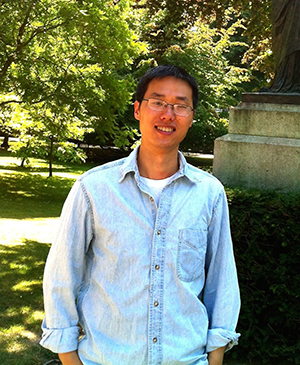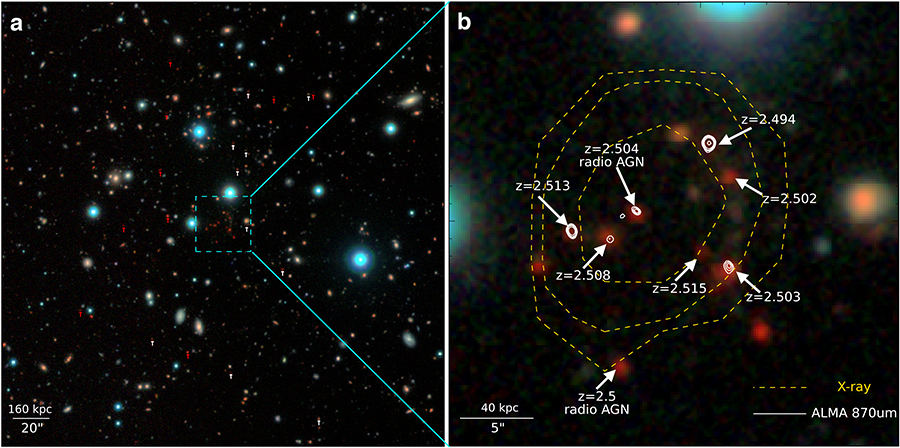Hunting For the Most Distant Galaxy Cluster

Tao Wang
We are pleased to welcome Dr. Tao Wang as a guest blogger. Tao is the first author of a paper that is the subject of our latest press release, about an extremely distant galaxy cluster. Tao is now a postdoc in CEA/Saclay, France, working with Dr. David Elbaz on high-redshift galaxies and galaxy clusters, and received a PhD in astrophysics from Nanjing University, China in 2012. During his PhD, he worked for two years in the Harvard-Smithsonian Center for Astrophysics and then worked as an associate researcher back in Nanjing University for one year before starting his postdoctoral work at CEA/Saclay in 2013.
Galaxy clusters are the largest known gravitationally bound structures in the universe and usually consist of hundreds of galaxies distributed in a relatively small area a few million light-years across. One of the most prominent features of clusters is the presence of a predominant population of massive, elliptical galaxies in the cluster core. These galaxies are among the most massive galaxies in the universe and are believed to have rapidly formed their stars a long time ago. However, how these galaxies formed and why have they stopped forming new stars remain mysteries. Solving these mysteries is essential to our understanding of both galaxy and cluster formation. To answer these questions, the key is to search for and study galaxy clusters (or their progenitors) in the early universe, right when they form.
Around March 2014, I was working on a project on how to identify massive galaxies at extremely high redshifts (the shift of the light of a galaxy to the red, denoted by “z”, measures its apparent velocity which can be converted into a distance from us, using the expansion law of the universe). At these high redshifts (z > 3-4), we can see galaxies as they were 12 billion years ago, or 1.8 billion years after the Big Bang that occurred about 13.8 billion years ago. While we figured out a way to select them, we faced another problem: the selection method included many contaminants, due to the presence of interstellar dust also responsible for a reddening of the light of a galaxy. These contaminants turned out to be very interesting by themselves, however, at that time I was only thinking about how to get rid of them.

An optical image of the center of CL J1001, from ESO's UltraVISTA survey. The right panel shows a close-up view with the redshifts of galaxies labeled, and two galaxies containing actively growing black holes labeled as "AGN". Credit: T.Wang.
Then one afternoon after having some green tea, I decided to spend some time to look in detail at the properties of these contaminants. As expected they were indeed the most massive and dust-obscured galaxies at their cosmic epoch 11 billion years ago (z~2-3), but I realized that since massive galaxies are expected to live in the most massive structures of the universe, they might pinpoint the rare distant galaxy cluster population. So I started to check the clustering properties of these galaxies and compare them with other galaxies at similar redshifts. When I placed them on a two-dimensional figure, I discovered that the sky positions of these massive galaxies were clustered close to the center of the figure. I then checked their optical/near-infrared images to make sure that this clustering of positions was not caused by some problems in the catalog. The images were quite astonishingly showing tens of massive galaxies clustered in a very small region (several tens of arc-seconds across). However, to be sure that the structure was real and not due to random alignments of galaxies located at different distances, I needed to know the actual distances of the galaxies. Using a technique to measure the rough redshift of galaxies from their colors, the “photometric redshift” technique, I found that there was indeed a spike of the galaxies in this part of the sky located at z=2.5 (including a galaxy glowing brightly in light from hydrogen gas at z=2.5 found by our colleague, Francesco Valentino). If confirmed, this redshift would make this cluster the most distant galaxy cluster ever discovered. This was quite encouraging and made me wish to learn more about this object.
The more data I gathered on it, the more remarkable this cluster turned out to be. An unexpected and striking peculiarity of this structure was the sign that it contained galaxies producing new stars like crazy. I could see this from its huge amount of radiation in the far infrared as seen by the Herschel satellite, a radiation coming from its dust that must be heated by huge amounts of newly-formed stars. I was very excited about this and discussed the unique properties of this structure with my colleagues, Dr. David Elbaz and Dr. Emanuele Daddi. We had many interesting discussions, e.g., whether the system showed evidence for amplification of light from background galaxies by gravitational lensing, and finally we agreed that this structure was real!
With its remarkable concentration of massive galaxies and its exceptional level of star formation, we realized that this structure had to be experiencing a critical formation phase. This is when we started a whole campaign of follow-up observations to confirm its redshift and pinpoint its individual members. Over almost two years and after substantial efforts, we gathered data from IRAM-NOEMA, VLT/KMOS (ESO) and JVLA (NRAO), and measured spectroscopic redshifts for 17 galaxies belonging to the cluster, despite their extreme dust attenuation. All were consistent with being part of a single structure at a redshift of z=2.506.
The final piece of evidence, also one of the most critical ones, that this was a true galaxy cluster came from its extended X-ray emission detected with the Chandra and XMM-Newton observatories. In November 2014, our collaborator, Alexis Finoguenov, confirmed the detection of extended X-ray emission at the position of the structure. Together with the redshift information of the member galaxies, we became confident that we had discovered the most distant galaxy cluster known to date.
This newly-discovered galaxy cluster is not only the most distant one ever found, but also represents a unique phase in cluster formation with most of its massive galaxy members still actively forming stars. This means that by a rare chance, we can now directly observe how massive galaxies formed their stars and also shed light on what mechanisms may cause them to stop doing so, since older and closer clusters are populated by massive and “dead” galaxies. More observations have now been approved from some of the largest telescopes including HST and ALMA, to further investigate the physical mechanisms that drive galaxy evolution in clusters during this critical formation epoch. These observations should enable comprehensive studies of star formation, gas, and structural properties for a substantial number of cluster galaxies. In parallel, we have now started to expand our search to other similar structures in wider fields with the goal of ultimately unveiling the full formation path of massive galaxy clusters.
Please note this is a moderated blog. No pornography, spam, profanity or discriminatory remarks are allowed. No personal attacks are allowed. Users should stay on topic to keep it relevant for the readers.
Read the privacy statement
